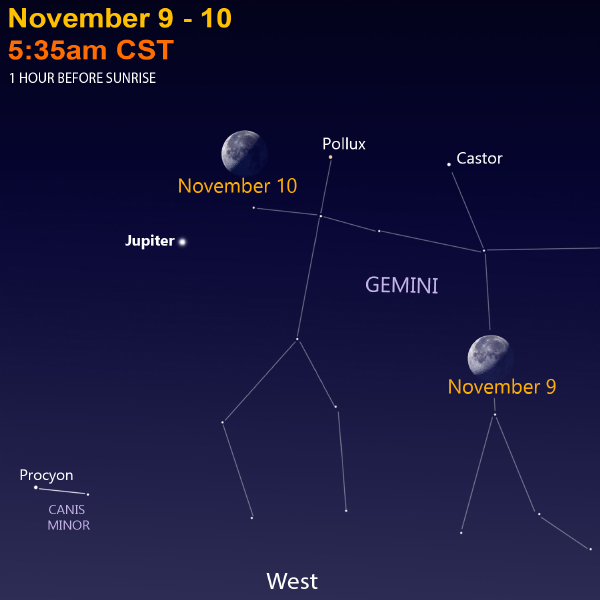Cosmic Curiosities
“If there is magic on this planet, it is contained in water.”
- Loren Eiseley, American Anthropologist
What’s the Big Deal About Water?
Evidence of Water Flows on Mars; credit: NASA
When you hear about space missions searching for water on the moon, Mars, or distant moons of Jupiter and Saturn, you might wonder: What’s the big deal about water? I mean, it’s not like we are going to live out in space anytime soon. And yet, we may. Though it seems farfetched—and probably not in most of our lifetimes—humans could be living in space within 100 years. Finding water will be crucial to any of those endeavors.
Water is essential for life. Water is needed for all our bodily functions—like regulating temperature, lubricating joints, and transporting nutrients. Without water, we can only survive for a few days. And we need freshwater, which is only 2.5% of all water on Earth. All the ocean’s saltwater is dangerous to humans. Consuming it will lead to severe dehydration, organ damage, and death. Saltwater has a much higher concentration of salt than the human body can process.
Every living thing on Earth depends on water. Almost all Earth creatures are over 50% water by weight. That’s why scientists believe that if we find water elsewhere in the solar system, they might find evidence for life—or at least the potential for it. Imagine the discovery of even simple microbial life on Mars or Europa, one of Jupiter’s moons. It would answer one of the oldest questions humans have ever asked: Are we alone?
But the search for water is not just about finding extraterrestrial life. It is about our future, too. The Earth is always changing, and lately, we have discovered it is changing because of us. Our population is growing, and climate change is affecting global water supplies and weather patterns. It is scary to think that if humanity is to survive, it may have to leave Earth and search for a place with water.
Hopefully, our path into space will be one of curiosity and exploration. If so, we will still need water for drinking and growing food. Water can also be used to produce oxygen and even rocket fuel by splitting the water molecule into hydrogen and oxygen. That means we would not have to haul tons of water from Earth, which is expensive and impractical.
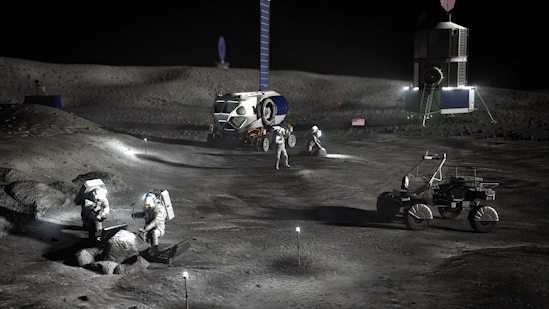
Artist Concept of Future Moon Astronauts; Credit NASA
Finding water may help us build permanent settlements in space. Imagine a lunar base with astronauts using ice mined from the moon’s poles to survive and explore deeper into the solar system, or a Mars colony using underground ice to support agriculture. These ideas are no longer just science fiction—they are being actively planned by NASA, SpaceX, and other agencies. Looking for water beyond Earth connects science, survival, and curiosity. It helps us learn more about the universe and our role and place in space.
Close Calls from Space
You may not have heard, but Earth had a pretty close call this past month! On October 1, Asteroid 2025 TF passed over Antarctica at 00:49 UTC at only 260 miles (420 km) from Earth. That makes it the second closest approach of any known asteroid!
How close is 260 miles? Well, space starts at 60 miles—straight up. The International Space Station (ISS) orbits 250 miles around the Earth. The moon’s orbit is 238,000 miles on average. So, this was a close call!
This rock was detected about six hours after its nearest point to Earth. The asteroid was small—about the size of a couch. It will return eventually, but not until 2087 and at a much farther distance.
Most of us know about asteroid dangers. Movies sensationalize their potential of mass destruction—but a large collision is still a possibility. It has happened before.
Meteor Crater-Arizona; credit: Ryan Anderson
Just 50,000 years ago, a nickel-iron meteorite estimated to be about 150 feet wide crashed into Earth in present-day Arizona. Now called Meteor Crater, it is the best-preserved impact crater on our planet. The crater is nearly a mile wide and 550 feet deep, and its impact was so powerful it was about 150 times greater than the atomic bomb dropped on Hiroshima. Today, it is a privately owned tourist site that also serves as a training ground for astronauts.
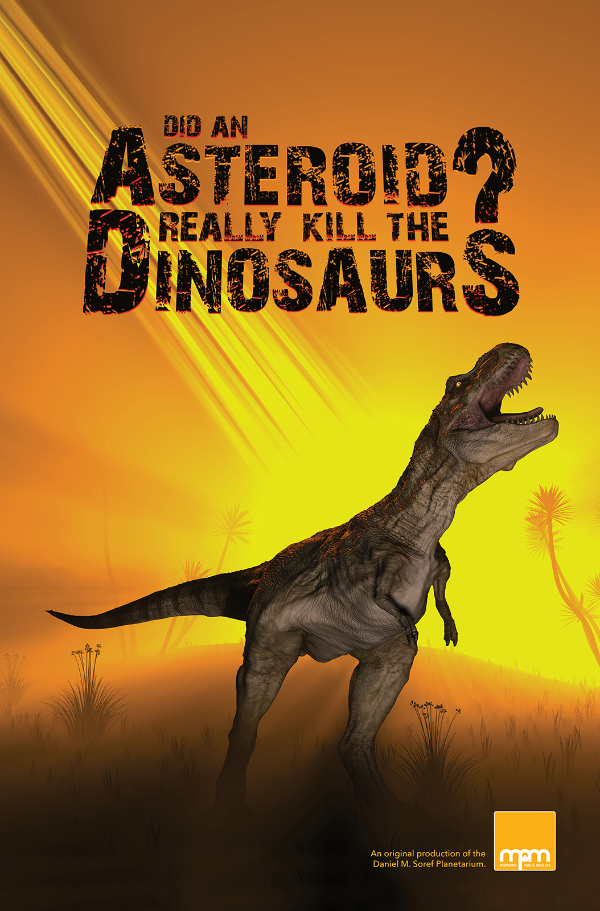
Soref Planetarium Program
And we did a whole Planetarium program on the six-mile-wide asteroid that killed the dinosaurs—and 70 percent of all living species on Earth—66 million years ago.
Today, there are many governments and groups that keep an eye on the skies for potential dangers. In the US, NASA established the Planetary Defense Coordination Office in 2016 to find, track, and better understand objects that could potentially impact our planet. The European Space Agency (ESA), Japan Aerospace Exploration Agency (JAXA), China National Space Administration (CNSA), and Russian Federal Space Agency (Roscosmos) also have asteroid defense plans. The Catalina Sky Survey, Minor Planet Survey, and the Japan Spaceguard Association also search the skies for rocks that could impact Earth. More than 60 organizations have signed the United Nation’s statement of intent for the International Asteroid Warning Network (United Nations 2025). NASA has even demonstrated the ability to deflect a tiny asteroid’s moon with the DART (Double Asteroid Redirection Test) mission in 2022. We still have a long way to go before we can deflect a large cataclysmic asteroid.
NASA’s DART Mission
With such a web of collaboration, these many space organizations have been able to find and predict the paths of objects before they enter our atmosphere. For example, Asteroid 2008 TC3 was detected on October 6, 2008, 20 hours before entry. Researchers were able to calculate an impact point in North Sudan as well as an estimated arrival time. Later, they even collected fragments in the Nubian Desert. Twenty hours may seem like a late detection, but 2008 TC3 was small, only about 13 feet long. More miniscule objects are typically harmless and usually break up in Earth’s atmosphere, so they are not actively tracked by observatories (ESA 2025).
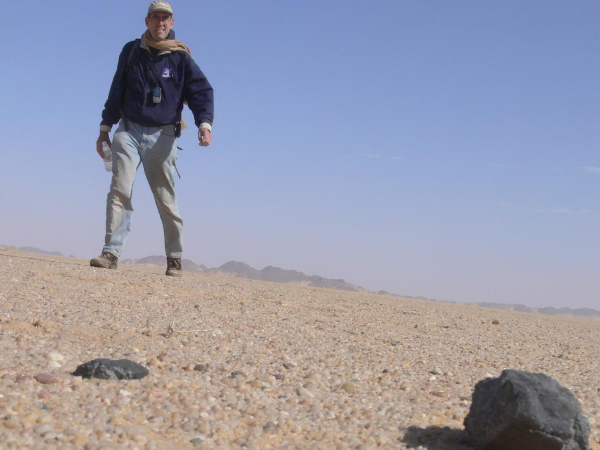
Astronomer Peter Jenniskens recovers fragments from 2008 TC3 in Sudan on February 28, 2009; credit: NASA / SETI / P. Jenniskens
Still, worries from space persist. Asteroid 99942 Apophis is named for the Egyptian god of chaos and destruction. After its discovery in 2004, scientists calculated a 2.9% chance of colliding with our planet in 2029, or if it missed, it could hit us in 2036. Apophis is a relatively large object, with its length spanning about five football fields. Thankfully for us, radar calculations during its most recent flyby in 2021 have ruled out a future impact for at least another hundred years.
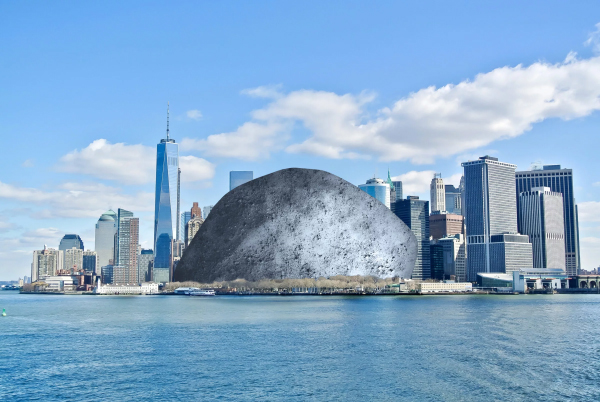
Artist’s concept of Apophis if it crashed peacefully into Manhattan Island; credit: The Planetary Society
In the foreseeable future, we do not have to worry much about a disastrous asteroid impact. Though we are pelted every day by meteorites, almost all are very small and harmless. We will continue to keep an eye out worldwide for any potential peril, and as we do so, keep learning about our incredible universe.
Orion = COLD!

Today, our daily schedules are governed by clocks—seemingly everywhere. It could be a wristwatch, a Fitbit, your smart phone, or a clock on the wall.
Take a break from these modern timekeepers, and look up to the skies. We humans did it for centuries. We charted the sun, moon, planets, and stars to tell time. They announced the day, the month, and the seasons. To track changes, some cultures built elaborate clocks like Stonehenge in England and ancient gnomons in China. Plants and animals still use the changing amount of sunlight to direct their biological functions.
The return of the bright stars of Orion the Hunter to the evening sky means November—which means cold. He leaves our evening sky in late April—which means cold wanes and warmer weather is on the way!
Space in Sixty Seconds
Dive deep into the constellation of Orion for two exquisite nebulae! Find Saturn, Jupiter, and the moon in the November night sky.
Sky Sights
Start your November sky tour with Saturn and the Moon from November 1 to 2. See the moon grow to full on November 5. This is the Beaver Moon—the time of year beavers get busy preparing for winter by making their dams and collecting food!
Venus gets more difficult to see low in the ESE as November mornings roll on. By December, it will be too close to the sun’s glare to see easily.
Jupiter still moves slowly amongst the stars of Gemini. On November 1, the largest planet rises at 10:30 p.m. CDT. On November 30, it rises at 7:30 p.m. CST. Remember, we “fall back” to standard time on Sunday, November 2. The Moon orbits by from November 9 to 10.
The Moon and Venus will both be difficult to see on the morning of November 18. It will be easier to spot the moon pass the bright star Spica on November 16 and 17.
Saturn and the Moon pair up again after sunset on November 28 and 29.
Mars is still too low in the west after sunset to be seen easily.
Mercury climbs high enough to see in the morning sky in very late November and early December.
November Star Map
Sign Up
Receive this newsletter via email!
Subscribe
See the Universe through a telescope
Join one of the Milwaukee-area astronomy clubs and spot craters on the Moon, the rings of Saturn, the moons of Jupiter, and much more.
Follow Bob on social media
Twitter: @MPMPlanetarium
Facebook: Daniel M. Soref Planetarium





